HRM: Total Reward System - Analysis, Strategies, and Examples
VerifiedAdded on 2023/01/18
|6
|1417
|54
Report
AI Summary
This report provides a comprehensive overview of total reward systems within the context of Human Resource Management (HRM). It delves into various aspects of reward systems, including different types of rewards (intrinsic and extrinsic), their impact on employee motivation, and strategies for implementation. The report examines the advantages and disadvantages of reward systems, considering factors such as risk management, budgeting conditions, and the influence of internal and external components. Furthermore, it provides real-world examples of how companies like Tesco utilize reward systems. The analysis culminates in a summary of key reasons for adopting a total reward system, emphasizing its role in attracting, motivating, and retaining employees to enhance organizational performance and productivity. The report uses Mark & Spencer as an example to illustrate the application of these concepts in a business setting.
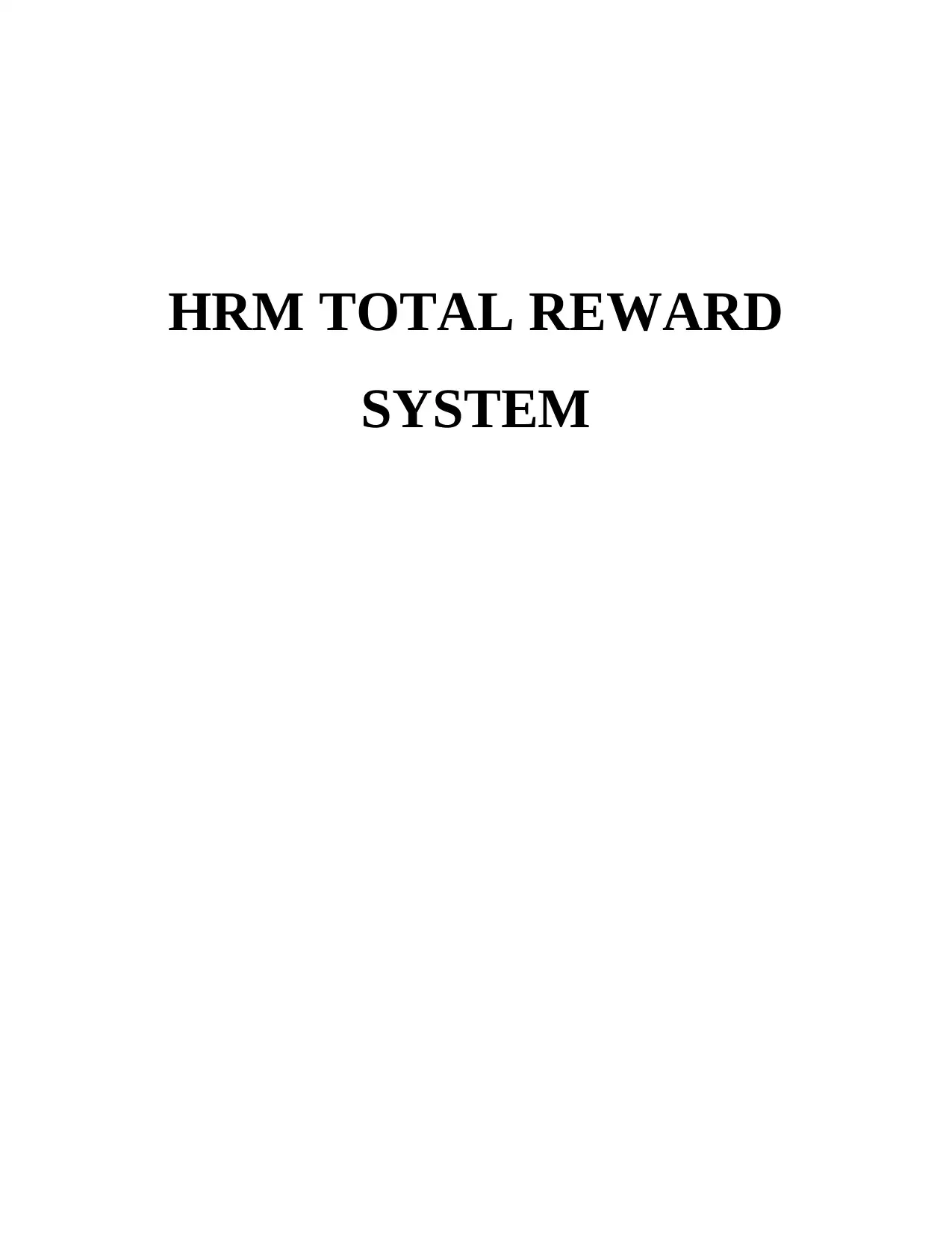
HRM TOTAL REWARD
SYSTEM
SYSTEM
Paraphrase This Document
Need a fresh take? Get an instant paraphrase of this document with our AI Paraphraser
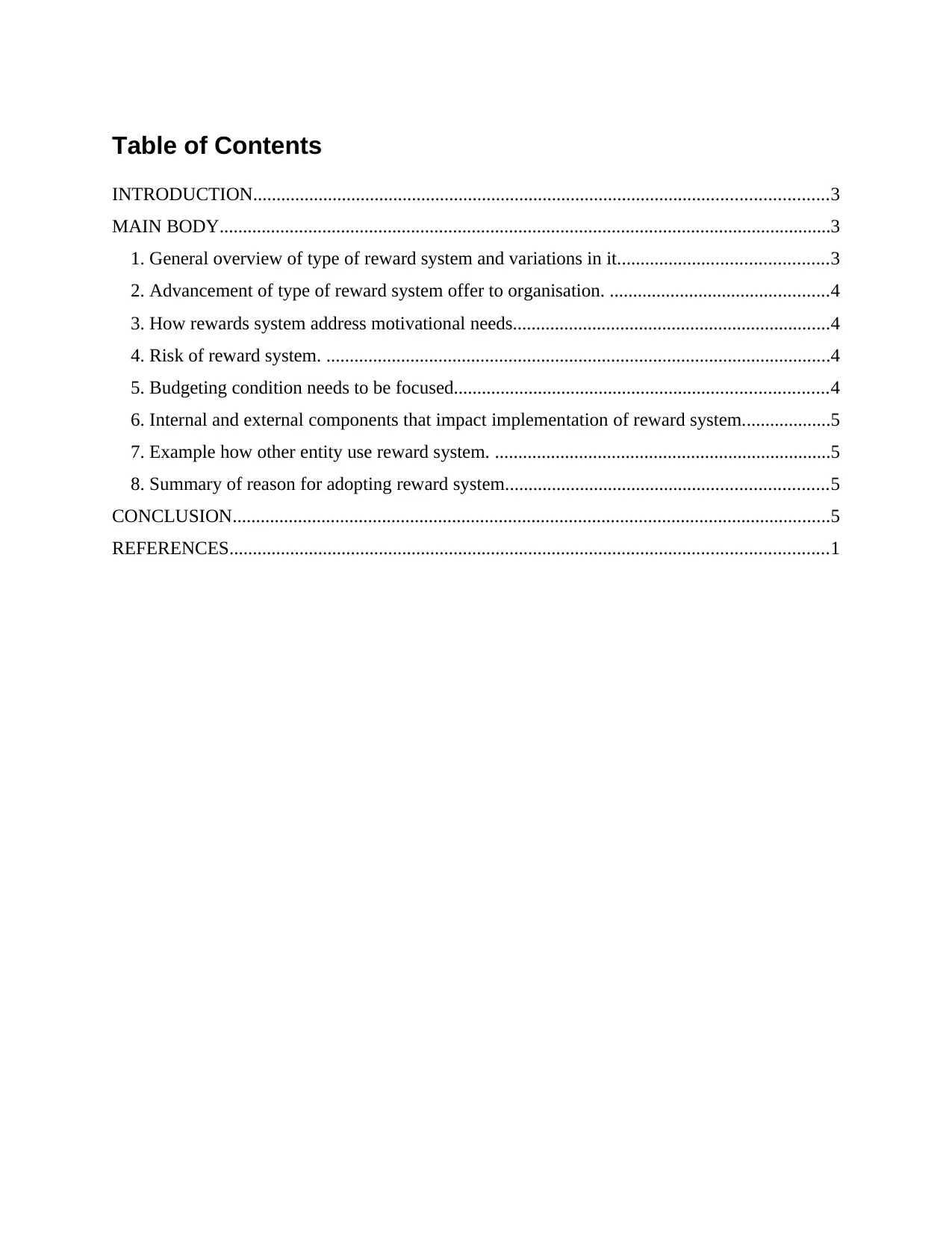
Table of Contents
INTRODUCTION...........................................................................................................................3
MAIN BODY...................................................................................................................................3
1. General overview of type of reward system and variations in it.............................................3
2. Advancement of type of reward system offer to organisation. ...............................................4
3. How rewards system address motivational needs....................................................................4
4. Risk of reward system. ............................................................................................................4
5. Budgeting condition needs to be focused................................................................................4
6. Internal and external components that impact implementation of reward system...................5
7. Example how other entity use reward system. ........................................................................5
8. Summary of reason for adopting reward system.....................................................................5
CONCLUSION................................................................................................................................5
REFERENCES................................................................................................................................1
INTRODUCTION...........................................................................................................................3
MAIN BODY...................................................................................................................................3
1. General overview of type of reward system and variations in it.............................................3
2. Advancement of type of reward system offer to organisation. ...............................................4
3. How rewards system address motivational needs....................................................................4
4. Risk of reward system. ............................................................................................................4
5. Budgeting condition needs to be focused................................................................................4
6. Internal and external components that impact implementation of reward system...................5
7. Example how other entity use reward system. ........................................................................5
8. Summary of reason for adopting reward system.....................................................................5
CONCLUSION................................................................................................................................5
REFERENCES................................................................................................................................1
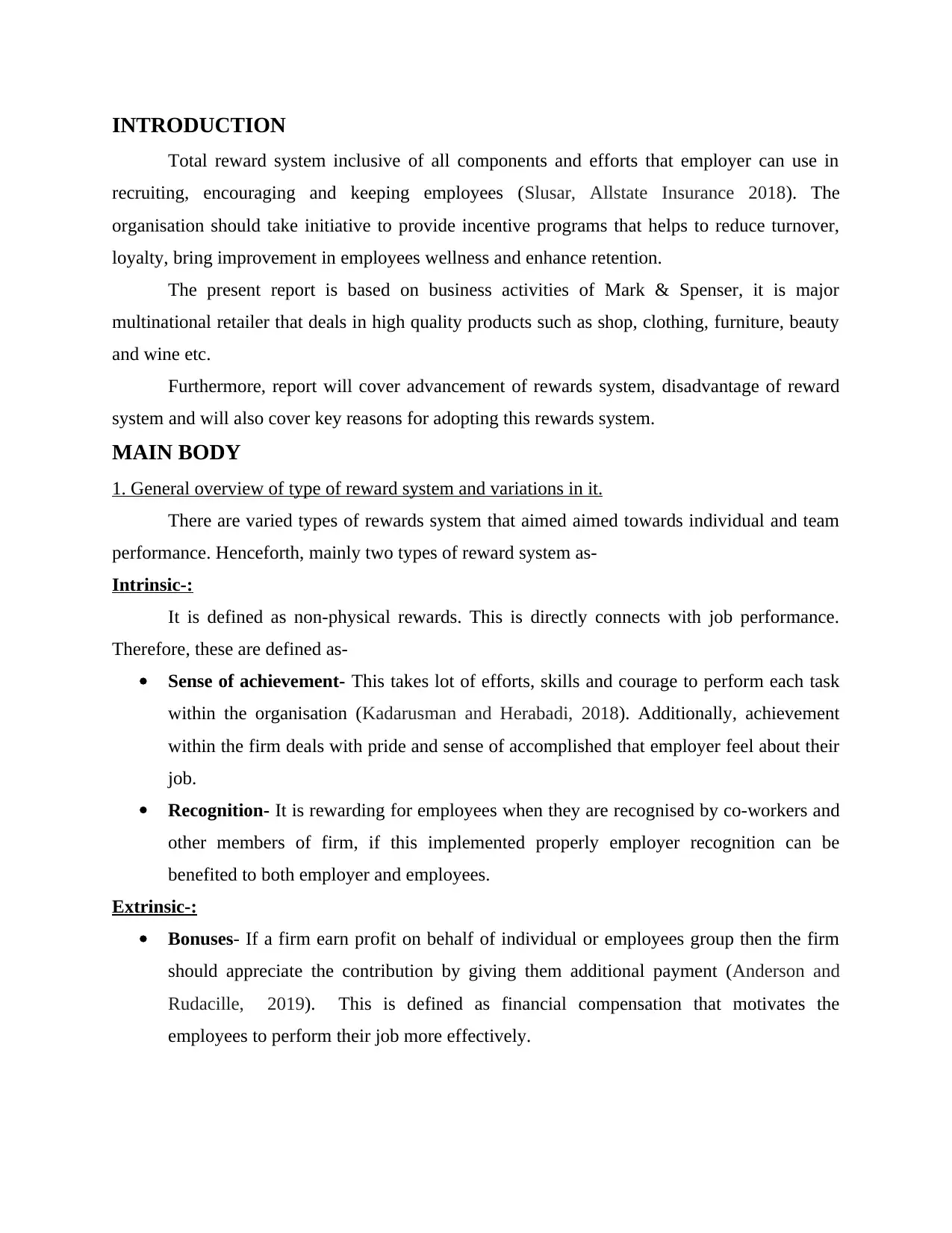
INTRODUCTION
Total reward system inclusive of all components and efforts that employer can use in
recruiting, encouraging and keeping employees (Slusar, Allstate Insurance 2018). The
organisation should take initiative to provide incentive programs that helps to reduce turnover,
loyalty, bring improvement in employees wellness and enhance retention.
The present report is based on business activities of Mark & Spenser, it is major
multinational retailer that deals in high quality products such as shop, clothing, furniture, beauty
and wine etc.
Furthermore, report will cover advancement of rewards system, disadvantage of reward
system and will also cover key reasons for adopting this rewards system.
MAIN BODY
1. General overview of type of reward system and variations in it.
There are varied types of rewards system that aimed aimed towards individual and team
performance. Henceforth, mainly two types of reward system as-
Intrinsic-:
It is defined as non-physical rewards. This is directly connects with job performance.
Therefore, these are defined as-
Sense of achievement- This takes lot of efforts, skills and courage to perform each task
within the organisation (Kadarusman and Herabadi, 2018). Additionally, achievement
within the firm deals with pride and sense of accomplished that employer feel about their
job.
Recognition- It is rewarding for employees when they are recognised by co-workers and
other members of firm, if this implemented properly employer recognition can be
benefited to both employer and employees.
Extrinsic-:
Bonuses- If a firm earn profit on behalf of individual or employees group then the firm
should appreciate the contribution by giving them additional payment (Anderson and
Rudacille, 2019). This is defined as financial compensation that motivates the
employees to perform their job more effectively.
Total reward system inclusive of all components and efforts that employer can use in
recruiting, encouraging and keeping employees (Slusar, Allstate Insurance 2018). The
organisation should take initiative to provide incentive programs that helps to reduce turnover,
loyalty, bring improvement in employees wellness and enhance retention.
The present report is based on business activities of Mark & Spenser, it is major
multinational retailer that deals in high quality products such as shop, clothing, furniture, beauty
and wine etc.
Furthermore, report will cover advancement of rewards system, disadvantage of reward
system and will also cover key reasons for adopting this rewards system.
MAIN BODY
1. General overview of type of reward system and variations in it.
There are varied types of rewards system that aimed aimed towards individual and team
performance. Henceforth, mainly two types of reward system as-
Intrinsic-:
It is defined as non-physical rewards. This is directly connects with job performance.
Therefore, these are defined as-
Sense of achievement- This takes lot of efforts, skills and courage to perform each task
within the organisation (Kadarusman and Herabadi, 2018). Additionally, achievement
within the firm deals with pride and sense of accomplished that employer feel about their
job.
Recognition- It is rewarding for employees when they are recognised by co-workers and
other members of firm, if this implemented properly employer recognition can be
benefited to both employer and employees.
Extrinsic-:
Bonuses- If a firm earn profit on behalf of individual or employees group then the firm
should appreciate the contribution by giving them additional payment (Anderson and
Rudacille, 2019). This is defined as financial compensation that motivates the
employees to perform their job more effectively.
⊘ This is a preview!⊘
Do you want full access?
Subscribe today to unlock all pages.

Trusted by 1+ million students worldwide
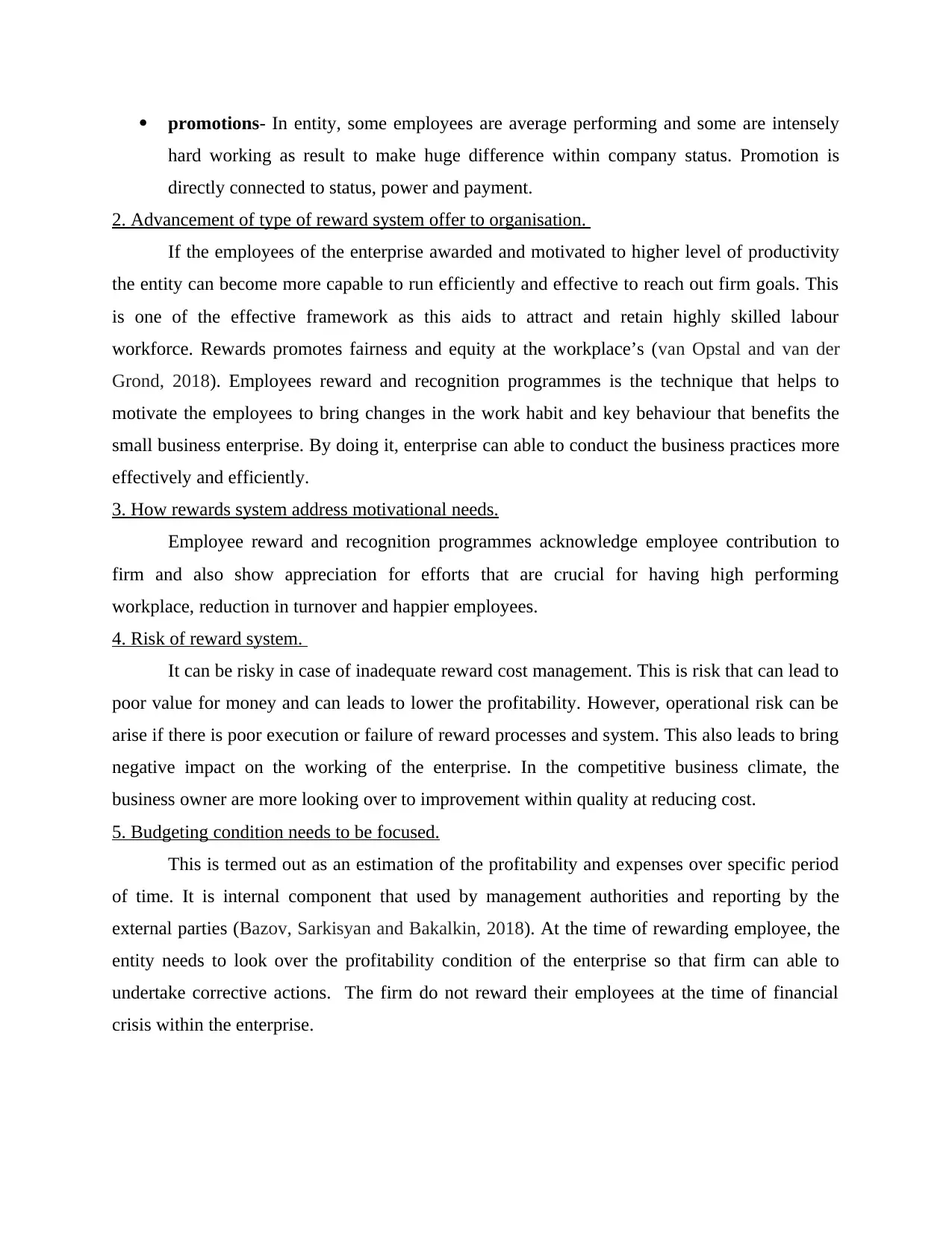
promotions- In entity, some employees are average performing and some are intensely
hard working as result to make huge difference within company status. Promotion is
directly connected to status, power and payment.
2. Advancement of type of reward system offer to organisation.
If the employees of the enterprise awarded and motivated to higher level of productivity
the entity can become more capable to run efficiently and effective to reach out firm goals. This
is one of the effective framework as this aids to attract and retain highly skilled labour
workforce. Rewards promotes fairness and equity at the workplace’s (van Opstal and van der
Grond, 2018). Employees reward and recognition programmes is the technique that helps to
motivate the employees to bring changes in the work habit and key behaviour that benefits the
small business enterprise. By doing it, enterprise can able to conduct the business practices more
effectively and efficiently.
3. How rewards system address motivational needs.
Employee reward and recognition programmes acknowledge employee contribution to
firm and also show appreciation for efforts that are crucial for having high performing
workplace, reduction in turnover and happier employees.
4. Risk of reward system.
It can be risky in case of inadequate reward cost management. This is risk that can lead to
poor value for money and can leads to lower the profitability. However, operational risk can be
arise if there is poor execution or failure of reward processes and system. This also leads to bring
negative impact on the working of the enterprise. In the competitive business climate, the
business owner are more looking over to improvement within quality at reducing cost.
5. Budgeting condition needs to be focused.
This is termed out as an estimation of the profitability and expenses over specific period
of time. It is internal component that used by management authorities and reporting by the
external parties (Bazov, Sarkisyan and Bakalkin, 2018). At the time of rewarding employee, the
entity needs to look over the profitability condition of the enterprise so that firm can able to
undertake corrective actions. The firm do not reward their employees at the time of financial
crisis within the enterprise.
hard working as result to make huge difference within company status. Promotion is
directly connected to status, power and payment.
2. Advancement of type of reward system offer to organisation.
If the employees of the enterprise awarded and motivated to higher level of productivity
the entity can become more capable to run efficiently and effective to reach out firm goals. This
is one of the effective framework as this aids to attract and retain highly skilled labour
workforce. Rewards promotes fairness and equity at the workplace’s (van Opstal and van der
Grond, 2018). Employees reward and recognition programmes is the technique that helps to
motivate the employees to bring changes in the work habit and key behaviour that benefits the
small business enterprise. By doing it, enterprise can able to conduct the business practices more
effectively and efficiently.
3. How rewards system address motivational needs.
Employee reward and recognition programmes acknowledge employee contribution to
firm and also show appreciation for efforts that are crucial for having high performing
workplace, reduction in turnover and happier employees.
4. Risk of reward system.
It can be risky in case of inadequate reward cost management. This is risk that can lead to
poor value for money and can leads to lower the profitability. However, operational risk can be
arise if there is poor execution or failure of reward processes and system. This also leads to bring
negative impact on the working of the enterprise. In the competitive business climate, the
business owner are more looking over to improvement within quality at reducing cost.
5. Budgeting condition needs to be focused.
This is termed out as an estimation of the profitability and expenses over specific period
of time. It is internal component that used by management authorities and reporting by the
external parties (Bazov, Sarkisyan and Bakalkin, 2018). At the time of rewarding employee, the
entity needs to look over the profitability condition of the enterprise so that firm can able to
undertake corrective actions. The firm do not reward their employees at the time of financial
crisis within the enterprise.
Paraphrase This Document
Need a fresh take? Get an instant paraphrase of this document with our AI Paraphraser
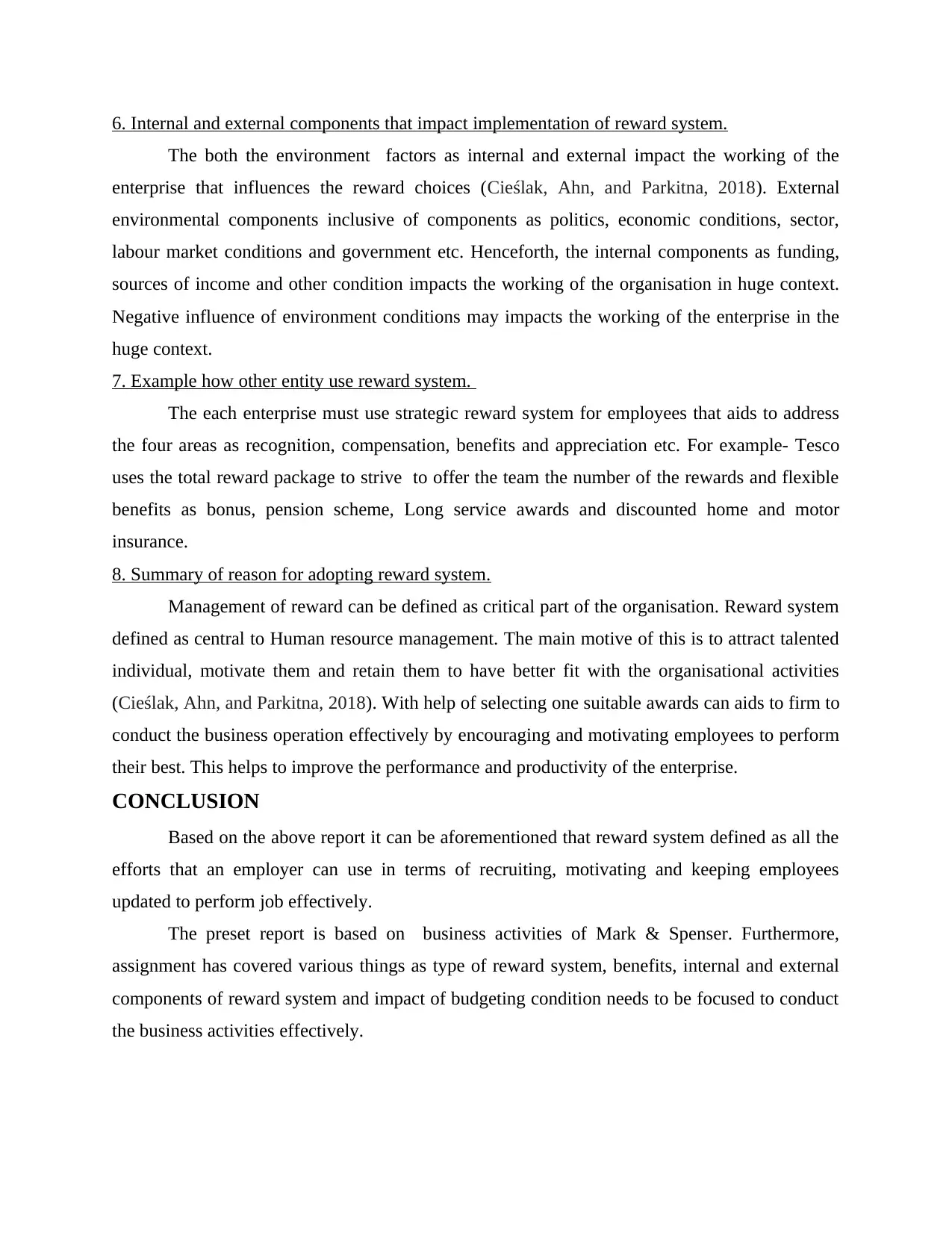
6. Internal and external components that impact implementation of reward system.
The both the environment factors as internal and external impact the working of the
enterprise that influences the reward choices (Cieślak, Ahn, and Parkitna, 2018). External
environmental components inclusive of components as politics, economic conditions, sector,
labour market conditions and government etc. Henceforth, the internal components as funding,
sources of income and other condition impacts the working of the organisation in huge context.
Negative influence of environment conditions may impacts the working of the enterprise in the
huge context.
7. Example how other entity use reward system.
The each enterprise must use strategic reward system for employees that aids to address
the four areas as recognition, compensation, benefits and appreciation etc. For example- Tesco
uses the total reward package to strive to offer the team the number of the rewards and flexible
benefits as bonus, pension scheme, Long service awards and discounted home and motor
insurance.
8. Summary of reason for adopting reward system.
Management of reward can be defined as critical part of the organisation. Reward system
defined as central to Human resource management. The main motive of this is to attract talented
individual, motivate them and retain them to have better fit with the organisational activities
(Cieślak, Ahn, and Parkitna, 2018). With help of selecting one suitable awards can aids to firm to
conduct the business operation effectively by encouraging and motivating employees to perform
their best. This helps to improve the performance and productivity of the enterprise.
CONCLUSION
Based on the above report it can be aforementioned that reward system defined as all the
efforts that an employer can use in terms of recruiting, motivating and keeping employees
updated to perform job effectively.
The preset report is based on business activities of Mark & Spenser. Furthermore,
assignment has covered various things as type of reward system, benefits, internal and external
components of reward system and impact of budgeting condition needs to be focused to conduct
the business activities effectively.
The both the environment factors as internal and external impact the working of the
enterprise that influences the reward choices (Cieślak, Ahn, and Parkitna, 2018). External
environmental components inclusive of components as politics, economic conditions, sector,
labour market conditions and government etc. Henceforth, the internal components as funding,
sources of income and other condition impacts the working of the organisation in huge context.
Negative influence of environment conditions may impacts the working of the enterprise in the
huge context.
7. Example how other entity use reward system.
The each enterprise must use strategic reward system for employees that aids to address
the four areas as recognition, compensation, benefits and appreciation etc. For example- Tesco
uses the total reward package to strive to offer the team the number of the rewards and flexible
benefits as bonus, pension scheme, Long service awards and discounted home and motor
insurance.
8. Summary of reason for adopting reward system.
Management of reward can be defined as critical part of the organisation. Reward system
defined as central to Human resource management. The main motive of this is to attract talented
individual, motivate them and retain them to have better fit with the organisational activities
(Cieślak, Ahn, and Parkitna, 2018). With help of selecting one suitable awards can aids to firm to
conduct the business operation effectively by encouraging and motivating employees to perform
their best. This helps to improve the performance and productivity of the enterprise.
CONCLUSION
Based on the above report it can be aforementioned that reward system defined as all the
efforts that an employer can use in terms of recruiting, motivating and keeping employees
updated to perform job effectively.
The preset report is based on business activities of Mark & Spenser. Furthermore,
assignment has covered various things as type of reward system, benefits, internal and external
components of reward system and impact of budgeting condition needs to be focused to conduct
the business activities effectively.

REFERENCES
Books and journals
Slusar, M.V., Allstate Insurance Co, 2018. Reward system related to a vehicle-to-vehicle
communication system. U.S. Patent 10,096,067.
Kadarusman, Y.B. and Herabadi, A.G., 2018. Improving sustainable development within
Indonesian palm oil: the importance of the reward system. Sustainable Development.
26(4). pp.422-434.
Anderson, J. and Rudacille, W., 2019. Effects of gestational protein restriction on brain reward
system.
van Opstal, A.M. and van der Grond, J., 2018. The effect of consumption temperature on the
homeostatic and hedonic responses to glucose ingestion in the hypothalamus and the
reward system. The American journal of clinical nutrition. 107(1). pp.20-25.
Bazov, I., Sarkisyan, D.and Bakalkin, G., 2018. Dynorphin and κ-opioid receptor dysregulation
in the dopaminergic reward system of human alcoholics. Molecular neurobiology. 55(8).
pp.7049-7061.
Cieślak, P.E., Ahn, W.Y. and Parkitna, J.R., 2018. Selective effects of the loss of NMDA or
mGluR5 receptors in the reward system on adaptive decision-making. eNeuro, 5(4).
1
Books and journals
Slusar, M.V., Allstate Insurance Co, 2018. Reward system related to a vehicle-to-vehicle
communication system. U.S. Patent 10,096,067.
Kadarusman, Y.B. and Herabadi, A.G., 2018. Improving sustainable development within
Indonesian palm oil: the importance of the reward system. Sustainable Development.
26(4). pp.422-434.
Anderson, J. and Rudacille, W., 2019. Effects of gestational protein restriction on brain reward
system.
van Opstal, A.M. and van der Grond, J., 2018. The effect of consumption temperature on the
homeostatic and hedonic responses to glucose ingestion in the hypothalamus and the
reward system. The American journal of clinical nutrition. 107(1). pp.20-25.
Bazov, I., Sarkisyan, D.and Bakalkin, G., 2018. Dynorphin and κ-opioid receptor dysregulation
in the dopaminergic reward system of human alcoholics. Molecular neurobiology. 55(8).
pp.7049-7061.
Cieślak, P.E., Ahn, W.Y. and Parkitna, J.R., 2018. Selective effects of the loss of NMDA or
mGluR5 receptors in the reward system on adaptive decision-making. eNeuro, 5(4).
1
⊘ This is a preview!⊘
Do you want full access?
Subscribe today to unlock all pages.

Trusted by 1+ million students worldwide
1 out of 6
Related Documents
Your All-in-One AI-Powered Toolkit for Academic Success.
+13062052269
info@desklib.com
Available 24*7 on WhatsApp / Email
![[object Object]](/_next/static/media/star-bottom.7253800d.svg)
Unlock your academic potential
Copyright © 2020–2025 A2Z Services. All Rights Reserved. Developed and managed by ZUCOL.





